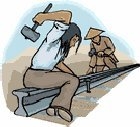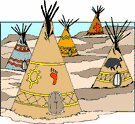
Worksheets and No Prep Teaching Resources
Reading Comprehension Worksheets
The United States Grows
(1865-1900)

The United States Grows
(1865-1900)
 Worksheets and No Prep Teaching Resources Reading Comprehension Worksheets The United States Grows (1865-1900) |
 The United States Grows (1865-1900) |
| edHelper's suggested reading level: | grades 6 to 8 | |
| Flesch-Kincaid grade level: | 6.6 |
|
Rails Across America - The Union Pacific Railroad in Indian Territory
By Toni Lee Robinson |

|
 1 In the 1860s, most Americans were clamoring for a railroad that would bridge the east-west gap. The question was how to get the Herculean job done. Some scoffed at the idea. It was impossible! What about the mountains? What about the Indians? What about the costs? Hardly anyone was willing to invest in what seemed a very risky venture.
1 In the 1860s, most Americans were clamoring for a railroad that would bridge the east-west gap. The question was how to get the Herculean job done. Some scoffed at the idea. It was impossible! What about the mountains? What about the Indians? What about the costs? Hardly anyone was willing to invest in what seemed a very risky venture. |
Create Weekly Reading Books
Prepare for an entire week at once! |
| Leave your feedback on Rails Across America - The Union Pacific Railroad in Indian Territory (use this link if you found an error in the story) |
 |
The United States Grows (1865-1900) |
 |
High School Reading Comprehensions and High School Reading Lessons
|
 |
United States
|
|
|
 | Fifty States Theme Unit |
 |
Document Based Activities |